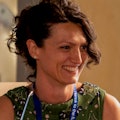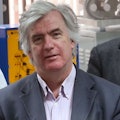Galaxies and Observational Cosmology
Galaxies are large assemblies of stars, ranging in size from tiny dwarf galaxies, containing only a few thousand stars, to the giant ellipticals found at the centres of clusters, which contain a thousand billion stars.
Our research group aims to understand the physical and chemical processes in galaxies, how galaxies were formed in the first place, and how they have evolved since they were formed.
We also use observations of galaxies and the cosmic microwave background to investigate the constituents of the universe, including the dark matter, dark energy and neutrinos. We use a mixture of theory and observations, using a variety of telescopes on the ground and in space, including instruments built by the Astronomy Instrumentation Group.
Questions we are trying to answer
What are the physical and chemical processes in a galaxy and how do these interact to generate the observed properties of the galaxy?
We are using a mixture of observations and theory to investigate these questions. At the moment we are particularly interested in the supermassive black holes at the centres of galaxies and how they affect the galaxies they live in. We are also particularly interested in the low-surface brightness galaxies that are hard to detect in conventional surveys but which will be detected in large numbers with telescopes such as the Large Synoptic Survey Telescope. Our group is also leading a large international team carrying out a survey of the gas, interstellar dust and star formation in the nearest big spiral galaxy, the Andromeda Galaxy.
How were galaxies formed, and how have they evolved since they were formed?
To find answers to these questions we are using theoretical modelling and observations of high-redshift galaxies, in particular galaxies magnified by gravitational lenses, which were detected in large numbers in our surveys with the Herschel Space Observatory. We have active programmes in this area on the Hubble Space Telescope and the Atacama Large Millimetre Array, and in the future expect to use the James Webb Space Telescope, the Square Kilometre Array and Euclid.
Where is all the dust that shrouds our universe formed?
Roughly half the optical light that has ever emitted by stars has been absorbed by interstellar dust. We are trying to investigate the properties of this dust and how it was formed. We have shown, surprisingly, a large amount of dust is formed in the violent explosions that are supernovae. We are currently using the Atacama Large Millimetre Array to watch the formation of cold dust and molecules in the recent supernova explosion SN 1987a.
What are the properties of dark matter, dark energy and neutrinos?
We are currently addressing this question using observations of the cosmic microwave background radiation, the radiation that was emitted by the universe only 400,000 years after the Big Bang. In the future, our group will also use the Square Kilometre Array, Euclid and the Large Synoptic Survey Telescope for this work.
How did the universe begin?
By observing the cosmic microwave background, we are trying to detect gravitational waves from a trillionth of a second after the Big Bang. At this time cosmic inflation stretched the initial density ripples to cosmological scales, leading, 13.7 billion years later, to the structures we see around us in the universe today.
Research
Our research projects
To help us achieve our objectives we lead and participate in major international research projects. Currently a large part of our research is exploiting the observations that are being made by the Herschel Space Observatory. Herschel observes the at far-infrared and sub-mm wavelengths which are particularly suited to the detection of cold material (-240°C) in the Universe. We are combining these data with those at other wavelengths to study a wide variety of physical processes related to galaxies.
AGES
The aim of AGES was to probe selected galaxy environments studying their properties through observations of atomic hydrogen. Hydrogen is the primary ingredient from which stars form and looking at the morphology and kinematics of the gas tells us a great deal about star formation and galaxy evolution. The survey used the largest and most sensitive single-dish telescope in the world - the 305m radio dish located at Arecibo, Puerto Rico.
H-ATLAS
H-ATLAS is the largest Herschel Open Time Key project and is designed to provide an extra-galactic survey of large areas of sky.
Professor Steve Eales, as Principal Investigator, was awarded 600 hours of time on Herschel to survey a huge area of the sky (550 square degrees), four times larger than all the other Herschel extragalactic surveys combined. We have used both the PACS and SPIRE cameras, which take pictures in infra-red and submillimetre light at wavelengths of 100, 160, 250, 350 and 500 µm. Herschel is the largest, most powerful infrared telescope ever flown in space and is the first space observatory to observe from the far-infrared to the submillimetre waveband, unveiling the mysterious hidden cold Universe to us for the first time. We have completed the observations for our survey and are now analyzing the results.
We have already used our first images to develop a new method for finding gravitational lenses, to study the cosmic evolution of galaxies over the last few billion years, and to find an ultra-low-mass protostar, results of which can be found at H-ATLAS.
Herschel Exploitation of Large Galaxy Andromeda (HELGA)
The HELGA project, was a Herschel study of the Andromeda galaxy or M31, for which Professor Walter Gear was the Principal Investigator.
Our Herschel observations, carried out over Christmas 2010, were the subject of an ESA press release. We have used the Herschel data to show that the properties of the dust grains in M31 appear to vary with the distance from the centre, which is not the case for our own galaxy. Our results also confirm that the rate at which stars are forming in Andromeda is much lower than in our own galaxy. The most exciting thing about our data is that, for the first time, we can study the formation of stars in individual giant molecular clouds in a galaxy other than our own.
The whole research group is primarily involved in these large Herschel observing programmes along with the collection of ancillary data at other wavelengths.
Herschel Reference Survey (HRS)
The HRS was an in depth survey of about 300 nearby galaxies led by Professor Eales.
This was a benchmark study of dust in the nearby Universe. We have used Herschel to produce images at 250, 350 and 500 microns of a statistically complete sample of 323 galaxies. The sample consists of galaxies with distances between 15 and 25 Mpc, with a flux limit in the K-band that effectively picks out the galaxies with the highest stellar masses in this volume of space. The sample spans the whole range of morphological types (ellipticals to late-type spirals) and environments (from the field to the centre of the Virgo Cluster). Overall, the Herschel Reference Survey represents the largest survey of nearby, extended, galaxies performed by Herschel and will thus represent an ideal reference for a number of other Herschel key project focused on the more distance universe.
Herschel Exploitation of Large Galaxy Andromeda (HELGA)
The HELGA project, was a Herschel study of the Andromeda galaxy or M31, for which Professor Walter Gear was the Principal Investigator.
Our Herschel observations, carried out over Christmas 2010, were the subject of an ESA press release. We have used the Herschel data to show that the properties of the dust grains in M31 appear to vary with the distance from the centre, which is not the case for our own galaxy. Our results also confirm that the rate at which stars are forming in Andromeda is much lower than in our own galaxy. The most exciting thing about our data is that, for the first time, we can study the formation of stars in individual giant molecular clouds in a galaxy other than our own.
The whole research group is primarily involved in these large Herschel observing programmes along with the collection of ancillary data at other wavelengths.
HeViCS and HeFoCS
Jonathan Davies was the Principal Investigator on two projects. The HeViCS is a large Open Time Key project to survey the nearby Virgo galaxy cluster and HeFoCS is an Open time project to study another nearby cluster Fornax.
The launch of Herschel opened up a new era for submillimeter astronomy, allowing the first accurate measurements of the dust emission in galaxies of all morphological types and luminosities. The HeVICS project (Virgo) was awarded 293 hours of Open Key Project Time to map the cluster. The HeFoCS project was awarded 34 hours of Open Time to map the Fornax cluster.
COMA cluster data was observed as part of H-ATLAS. Each cluster was observed at 100, 160, 250 350 and 500µm. The data will be used to study the dust properties in these nearby galaxies and the role played by dust in the star-formation cycle. Eventually the data will be combined with new data at UV, optical and near infrared to study the star formation histories of cluster galaxies. These surveys will provide the local cluster benchmark for environmental studies and comparison with younger distant clusters and field.
MESS
As well as extra-galactic studies we are also interested in the origin of the cold dust that gives rise to the far-infrared emission. We participate in MESS which is a Herschel survey to look at dust production in evolved stars in our the Milky Way. As part of MESS, Herschel will look in detail at evolved stars and five galactic supernova remnants. Herschel's photometers will image the dust emission and its spectrometers will search for signatures of molecules and dust. The MESS team, including Gomez, Gear and Hargrave published 9 papers in the Herschel special issue journal and one in Nature led by Leen Decin. These papers included the discovery of a new cool dust component in the Galactic supernova remnant Cassiopeia A (about 30,000 Earth's worth of dust) led by Mike Barlow.
We are also actively pursuing new projects linked to ALMA and the SKA.
Meet the team

Professor Erminia Calabrese
Director of Research
Astronomy Instrumentation Group and Astronomy Group
Cardiff Hub for Astrophysics Research and Technology

Professor Walter Gear
Honorary Professor
Astronomy Instrumentation Group
Cardiff Hub for Astrophysics Research and Technology

Dr Mattia Negrello
Senior Lecturer
Astronomy Group
Cardiff Hub for Astrophysics Research and Technology
Research units
Schools
Next steps
Research that matters
Our research makes a difference to people’s lives as we work across disciplines to tackle major challenges facing society, the economy and our environment.
Postgraduate research
Our research degrees give the opportunity to investigate a specific topic in depth among field-leading researchers.
Our research impact
Our research case studies highlight some of the areas where we deliver positive research impact.







